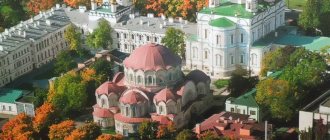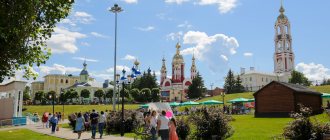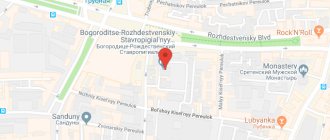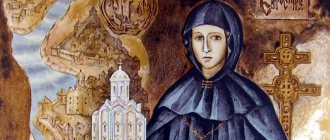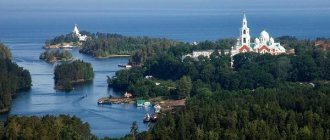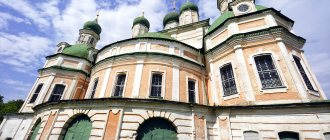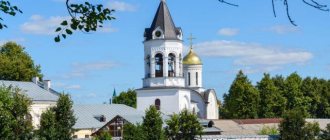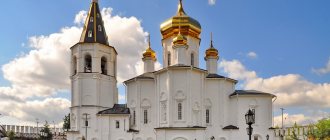The Alexander-Svirsky Monastery is one of the Orthodox spiritual centers operating in the Leningrad region. The men's monastery, regularly visited by pilgrims, travelers and tourist groups, is located in the village of Staraya Sloboda, 21 km from the town of Lodeynoye Pole. The remoteness of large settlements, virgin nature and the picturesque shore of Lake Roshchinskoye create a unique atmosphere of peace and harmony, promoting the awareness of spiritual truths and priorities.
View of the monastery from the shore of Lake Roshchinskoye, © Δημήτριος
Description of the Alexander-Svirsky Monastery
The Orthodox monastery, which includes famous architectural monuments of the 16th-17th centuries, was founded by Alexander Svirsky (1448-1533) at the end of the 15th century in the Olonets region (formerly Korelsky Land). At that time, these places were surrounded by dense forests and pagan settlements. The saint, now revered as a saint, quickly gained disciples and followers from among the indigenous population. The fame of the pious monk, which reached the most remote corners, attracted monks and lay people in need of prayerful help to his place of residence.
Even during the life of the Monk Alexander, two territorially separated complexes were formed in the monastery, connected by a path trodden along the lake:
- Trinity - at the fraternal cells;
- Preobrazhensky - next to the monastery cemetery.
Alexander-Svirsky Monastery in the 18th - early 19th centuries. called "Northern Lavra". He controlled about 30 monasteries and local deserts (remote monastic settlements).
The main part of the monastery's buildings was perfectly preserved, despite periodic raids by enemies and the difficult post-revolutionary period, when the relics of Alexander Svirsky were taken away, the sacristy was looted, ancient icons were destroyed, and the monks were dispersed or shot. In different years of the twentieth century, the territory and unique architectural monuments were used as a forced labor camp for prisoners, a nursing home, a psychiatric hospital and barracks.
The restoration of the Alexander-Svirsky Monastery began in 1997. The new inhabitants have made a lot of efforts, but today the complex is in need of major restoration efforts.
Church of the Intercession of the Blessed Virgin Mary with a refectory, © Masha Malinovskaya
Temples of the monastery
In the Trinity complex there are:
- Church of the Intercession of the Mother of God - built of stone in 1533–36. under Alexander Svirsky at the sacrificial funds of the Sovereign and Grand Duke of All Rus' Vasily III. The oldest (surviving) monastery church has a refectory;
- Trinity Cathedral - a stone structure erected in 1695–97. on the site of the wooden church of the same name, founded in 1508, and the stone church that replaced it in 1526. Inside the cathedral, frescoes created in 1709 have been preserved;
- belfry - a multi-span three-tiered structure with three tents appeared around 1646–48. Previously, the structure was wooden, with five tents;
- Church of St. John of Damascus - was built in 1716–18.
Three-tented belfry, © Lyudmila
On the territory of the Preobrazhensky complex there are:
- Transfiguration Cathedral - a wooden frame was erected in 1533, but during the period of the Polish-Lithuanian devastation (1618) it burned down. The stone structure was erected in 1641, and the chapel in the name of the founder of the monastery was erected in 1716. Later, the cathedral was reconstructed several times;
- Church of St. Zechariah and St. Elizabeth - added to the Transfiguration Cathedral in 1685;
- Gate Church of St. Nicholas the Wonderworker - located in the bishop's chambers above the entrance to the complex. Construction date unknown;
- Chapel of the Life-Giving Trinity - erected in 1791 on the foundation of a wooden church built by the founder of the monastery on the site of the appearance of the Most Holy Trinity to him;
- Chapel of Alexander Svirsky - located outside the Preobrazhensky complex. It was built in 1791 over a well, personally dug by the founder of the monastery and consecrated for the brethren;
- bell tower - erected in 1903-1904.
Gate Church of St. Nicholas the Wonderworker, © Masha Malinovskaya
In addition to the temples, the Alexander-Svirsky Monastery houses buildings - the bishop's, fraternal and cell buildings. Each of the two complexes is surrounded by walls. You can enter through the gate. In the open areas there are wide paths, plaster vases with flowers, lawns, benches, and lamps.
History of the monastery
The long chronicle of the Alexander-Svirsky Monastery, full of wonderful and tragic pages, began more than 500 years ago. This holy monastery is a great historical and architectural monument of the 16th-17th centuries.
Construction of the monastery and its founder
The creator and spiritual father of the Svirsky Monastery, the Monk Alexander, was born in the middle of the 15th century. From a young age, he decided to become a monk, for which he went to Valaam, where at the age of 26 he took monastic vows. For many years the Monk Alexander lived as a hermit in a cave on one of the Valaam Islands and earned the fame of a holy man. At the age of 37, when his fame became a burden to him, he retired to the forests on the banks of the Svir River in the vicinity of Lake Roshchinskoye, where he lived in solitude for several more years.
But the hermit’s followers found him there too. Gradually, a monastic settlement was formed next to his abode. The Monk Alexander ordered the construction of monastic cells at a distance from his monastery - on the shores of the Holy Lake. And he designated his place of residence for a monastic cemetery, the so-called waste hermitage.
The appearance of the Holy Trinity and the discovery of the relics of the saint
In one of the prayers of St. Alexander, the Holy Trinity appeared to him. To commemorate this miraculous event, not far from the site of the apparition, the Church of the Holy Trinity was founded in a monastic settlement. For its construction, master masons and abundant monetary donations were sent from the capital by Vasily III, who reigned in those years. Nearby, the Reverend Father Alexander began the construction of a stone refectory and the Church of the Intercession of the Most Holy Theotokos, which were erected in the year of his eternal repose.
On the territory of the waste hermitage, the Reverend Father Alexander Svirsky ordered the construction of a wooden Cathedral of the Transfiguration of the Lord in 1533. Thus, at the beginning of the 16th century, the Holy Trinity Monastery was created, which included the Trinity and Transfiguration halves. The Monk Alexander Svirsky, who died in 1533, was buried with honors at the altar of the wooden Church of the Transfiguration. After another 18 years, he was canonized, and in 1641, during the construction of the stone Transfiguration Monastery Cathedral, his holy incorruptible relics were discovered.
Immediately after the discovery, the holy remains were transferred to the church of St. Nicholas, preserved after the destruction and burning of the monastery by the Poles in 1612. After 3 years, the imperishable relics in a silver shrine found their place in the monastery’s Transfiguration Cathedral, which was newly rebuilt from stone. After the October Revolution in 1918, the holy remains were taken as an exhibit to the Military Medical Academy, and only 80 years later were they returned to the monastery. Now the holy relics reside in the Transfiguration Cathedral and are solemnly transferred in procession to the Trinity Cathedral annually on the days of the celebration of the Holy Trinity.
The destruction of the monastery and its restoration
Over the five centuries of its existence, the Holy Trinity Alexander Svirsky Monastery has experienced periods of prosperity and decline. In 1581, the first destruction of the monastery by the Swedes occurred, and in 1612-1613 the monastery was captured by the Poles and Lithuanians.
The enemies captured and brutally tortured Abbot Paisius, as well as 55 monks and workers, demanding that they give them monastery valuables and funds, but they never received anything. Cells and service buildings were destroyed, and the Church of the Transfiguration was burned. The Trinity Church was cracked by the fire, and only the walls remained of the Church of the Intercession of the Holy Virgin. Residents of the Alexander-Svirsky Monastery and neighboring monasteries, together with the peasants, stood up to defend their region and expelled the invaders.
Immediately after the expulsion of the Polish invaders, the restoration of the Alexander Svirsky Monastery began, and by 1620 the monastery was restored. After this Alexander Svirsky, the monastery entered its heyday. Over time, it united 30 monasteries around itself and became a real stronghold of Russian Orthodoxy, as it was then called - the Northern Lavra.
After the revolution of 1917, the monastery was destroyed, church valuables were confiscated. The rector of the monastery, Archimandrite Eugene, as well as some of the monks and laymen were shot. The relics of St. Alexander were subjected to desecration and then transferred to the Military Medical Academy. The premises of the Svir monastery were nationalized; during the years of Soviet power, they housed an orphanage, a forced labor camp, a home for the disabled, an agricultural technical school, and a psychiatric hospital. One of the buildings of the mental hospital is still located on the territory of the Trinity part, but the authorities plan to vacate this building soon.
In 1997, the revival of the monastery began. Its new residents had to work hard to restore everything that had been destroyed and fallen into disrepair. A significant event for the monastery was the return of the holy relics of its founder, the Monk Alexander of Svirsky.
Current state
Today the Alexander-Svirsky Monastery is a functioning male monastic settlement, open to the public. On its territory there are five churches of the 16th-18th centuries, a belfry, a refectory, a bell tower, monastic cells and service premises.
Relics of Alexander Svirsky
The main shrine of the monastery is the relics of its founder. Even in the most difficult times, accompanied by enemy invasions, looting and fires, no one dared to touch the incorruptible remains of the saint. However, in 1918, the relics of Alexander Svirsky were seized, opened, examined, taken out and placed in one of the anatomical museums. The exhibit was listed for a long time as “the mummified body of an unknown man.” It took a lot of time to find the incorruptible flesh and examine it, but some historians continue to express doubts about the veracity of the shrine.
The second discovery of the relics of Alexander Svirsky took place on July 30, 1998, which became a major event for the reviving monastery.
Frescoes, © Lyudmila
The Alexander-Svirsky Monastery houses several more shrines, including:
- place of the appearance of the Holy Trinity;
- place of the appearance of the Blessed Virgin Mary;
- a copy of the Shroud of Turin;
- icons and frescoes;
- holy springs of drinking water.
Alexander-Svirsky Monastery - official website
Shrines and relics
The main shrine of Alexander of the Svirsky Monastery, which attracts thousands of pilgrims here, is the holy relics of St. Alexander, kept in the Cathedral of the Transfiguration of the Lord. During the celebration of Trinity, the shrine is transferred in a solemn procession to the Holy Trinity Cathedral.
There is also a consecrated copy of the Shroud of Turin, delivered to the monastery in 2006 for the five-century anniversary of its foundation. This was one of 6 copies of the Shroud of Turin that existed in the world at that time. After a short period of time, this shrine became silent.
In 2013, the Alexander Svirsky Monastery received a donation from the Odessa diocese of an ark containing pieces of 26 shrines, among them holy relics and pieces of sacred objects: the manger of the baby Jesus, the tunic of St. Joseph, etc.
The holy spring located at the entrance to the Preobrazhenskaya part of the monastery also belongs to the shrines of the Svirskaya monastery.
Hotels near the Svirsky Monastery
The Staraya Sloboda hotel is located 10 minutes from the complex. Guests can enjoy comfortable rooms with private bathrooms, refrigerators and TVs. On site there is a restaurant, playgrounds, an equestrian club, parking and a sauna. Free Wi-Fi and bicycle rentals are available to everyone.
Hotel near the Alexander-Svirsky Monastery on the map
Located a 5-minute walk from the monastery, the pilgrimage hotel offers shelter and food in the best hospitable traditions. Living here is subject to certain rules and responsibilities.
Schedule of work and services
The monastery is open daily from 06:00 to 20:00. On Sundays and holidays - from 08:00 to 20:00. The temple in which the relics of St. Alexander Svirsky, you can freely visit from Monday to Saturday from 10:00 to 17:00, and on Sunday from 12:00 to 17:00.
Trinity Cathedral, © Masha Malinovskaya
Anyone can come to church services. Tourists and excursion groups are allowed to view churches and chapels only after the end of services. Additional restrictions may concern issues related to the internal routine of the fraternity.
Schedule of services in the Alexander-Svirsky Monastery
How to get there
You can get to the settlement of Staraya Sloboda from St. Petersburg. The bus traveling on route No. 863 departs from bus station No. 2. The journey takes about five hours and there is no need to change trains.
From the Lodeynoye Pole bus station you can take bus No. 963 to the village of Pitkyaranta, change to bus 89 or 91 and get to the village. Svirskoe. But the most convenient way is to drive to the monastery in your own car. To do this, from St. Petersburg you should take the Murmansk highway. Near the Poklonny Cross you need to turn left and through Svirskoye get to Staraya Sloboda.
It is convenient to travel from other cities, including Moscow, as part of pilgrimage groups.
Monastery address: Leningrad region, Lodeynopolsky district, Staraya Sloboda village.
Visiting times and schedule of services
The monastery is open from six o'clock in the morning until eight o'clock in the evening. On holidays and Sundays, guests can arrive a little later, at eight in the morning. The courtyard can be accessed from Tuesday to Saturday from nine o'clock in the morning until four o'clock in the afternoon.
Divine service in the Alexander-Svirsky Monastery
For those who wish to venerate the relics of St. Alexander of Svirsky, the cathedral is open from Monday to Saturday. You can come from 10:00 to 17:00. On Sundays - from 12:00 to 17:00.
In the Trinity Cathedral on weekdays the Divine Liturgy is served from nine o'clock in the morning. The prayer service begins at 14:00. The rest of the time, the so-called hours are read, confessions are held, midnight offices and matins are served. Changes in the schedule of services may be due to holidays.
Visiting rules
Since the monastery belongs to a closed religious organization, when visiting it you must follow certain rules. It is not allowed to come in beach clothes or too revealing clothes, including shorts, breeches and miniskirts. Women are advised to cover their heads with a scarf and avoid trousers (in extreme cases, the lower part of the body can be wrapped in a piece of any fabric). It would be appropriate to turn off mobile phones when entering churches and chapels.
Photographs and videos on the territory, in churches and chapels are allowed only with the blessing of the clergy.
The following is strictly prohibited on the territory of the complex:
- smoke;
- drink alcohol;
- run;
- make noise;
- to swear;
- walk on the lawns;
- sunbathe and swim;
- enter residential premises and outbuildings.
Iconostasis, © Lyudmila
Excursions for groups can only be carried out with the blessing of the abbot of the monastery and accompanied by representatives of the pilgrimage service. The application must be sent in advance. More detailed information is posted on the official website of the Orthodox monastery.
Metochion of the Alexander-Svirsky Monastery
Before the 1917 revolution, the monastery's courtyard was located next to the Yamsky market in St. Petersburg. Today this building houses a tuberculosis dispensary, and for the construction of a new courtyard another place was allocated at the address: lane. Chelieva, 10.
A small Church of the Nativity of Christ was erected on the territory, in which two shrines are kept:
- The Life-Giving Cross of the Lord with particles of important Orthodox relics;
- The Zhirovitsky Icon of the Mother of God is an exact copy given by the Dormition Zhirovitsky Monastery.
Official website of the Svirsky Monastery Metochion
Description of the temples
The religious buildings of the Alexander-Svirsky monastery were erected in the 16th-18th centuries. All of them are in good condition, some of them have retained their original appearance to this day.
Transfiguration Monastery
The Transfiguration part of the monastery in certain periods of history was known as the Svirsky Transfiguration Monastery. It is fenced with a wall in which the monks' cells and service rooms are located. At its entrance there is a Holy Spring, above the entrance there is the Gate Church of St. Nicholas the Wonderworker, inside the courtyard there are the Transfiguration Cathedral, the Church of Zacharias, and the active chapel of the Holy Trinity.
Transfiguration Cathedral of St. Alexander Svirsky
The Cathedral of the Transfiguration of the Lord was originally wooden, its construction was completed in the year of the eternal rest of St. Alexander. In 1613, the temple was burned by Polish invaders. In its place in 1644, the stone Transfiguration Cathedral was erected, which has survived to this day.
During its existence, this Svir temple was reconstructed several times. In 1716, the chapel of St. Alexander of Svirsky was added to the building. In the mid-nineteenth century, wooden floors were replaced with steel ones, and individual window and door niches were expanded. Soon the design of the facade was changed.
In 1900, a choir for monks with pointed wooden railings was added to the western wall. After 3 years, the walls of the temple and the chapel inside were decorated with wall paintings. Now the Cathedral of the Transfiguration of the Lord is a majestic white temple with green domes and three ancient frescoes decorating the altar. Combined with the cathedral, the Zechariah Temple and the bell tower give the architectural composition a particularly solemn appearance.
Church of Saints Zechariah and Elizabeth
The single-domed Church of St. Zechariah and Righteous Elizabeth adjoins the Svirsky Transfiguration Cathedral with its northern façade and communicates with it through a vaulted gallery. It was erected in 1668 under the direction of master architect Maxim Semenov. The church building suffered serious damage during the fire of 1784. After 50 years, the church was renovated, and its appearance has changed greatly. Only one window above the door of the southern facade has survived from the time of construction of this temple. The adorning casing with a triangular pediment and two columns on the sides gives an idea of the original exterior decoration of the church.
Chapel of the Holy Trinity
The current chapel of the Holy Trinity is located at the entrance to the courtyard of the Transfiguration part of the monastery, to the left of the gate. It was erected on the site of the miraculous appearance of the Holy Trinity, which appeared in response to the prayers of St. Alexander. This chapel was erected in the second half of the 19th century, when Archimandrite Pavel was the rector of the Alexander Svirsky Monastery. Nowadays prayer services are held in this chapel. Near the chapel you can collect blessed sand, which has healing powers.
Trinity Monastery
The Trinity part of the Alexander-Svirsky Monastery at certain historical stages was called the Svirsky Trinity Monastery. It is surrounded by a monastery wall with monastic cells. In this part of the monastery, great architectural and historical monuments of the 16th century have been preserved - the Church of the Intercession of the Blessed Virgin Mary, as well as the Refectory Chambers.
Trinity Cathedral
On the sacred place indicated by the Reverend Father Alexander, in 1508 a log church was erected in honor of the Holy Trinity, which 18 years later was replaced by a stone one. After the plunder of the Svir monastery by the Poles in 1613, the walls of the church were cracked by fire; seven years later the temple was restored. And in 1695, the Trinity Cathedral was erected on the same spot, which has survived to this day. Kostroma stone masons took part in its construction: Pyotr Potemkin, Foma Alekseev, Yakov Agafonov. In 1698, the consecration of the temple by Job, Metropolitan of Novgorod, took place.
In 1715, the walls inside the temple were painted with frescoes, on which an artel of Kostroma icon painters, headed by Leonty Makarov, worked. Famous icon painters are mentioned in the chronicles of the monastery: Herodion Sergiev, Gavrila Sazonov and others. The cathedral's paintings remained unchanged, but in the 60s of the 20th century the frescoes fell away from the walls, and during restoration, restorers had to nail them down with special nails. The iconostasis with icons from the 17th century has also been preserved to this day. Now the Holy Trinity Cathedral is a white, four-pillar, single-domed church with a silver dome, surrounded by a gallery on a high basement. A steep staircase leads inside the temple.
Church of the Intercession of the Holy Virgin
One of the first churches erected in the Svirsky Monastery was the brick Church of the Intercession of the Holy Virgin. Its construction, together with the refectory, began during the life of the Rev. Father Alexander, and was completed in 1533. Members of the community took an active part in its construction, and they were led by the master architect Ignatius, sent by the Tsar from Moscow.
In 1613, the Church of the Intercession of the Holy Mother of God suffered greatly from the Polish invaders; only the foundation and part of the walls remained. After 7 years, the temple was restored, and now it is the oldest religious building of the Holy Trinity Monastery.
The elegant white building of the Church of the Intercession of the Holy Virgin is crowned with a dome soaring into the sky. Adjacent to it are the Refectory Chambers, built around the same years, decorated with a bell tower and two turrets. Nearby is a three-tier belfry, eye-catching with its three green domes, which was built in the 1640s. The Church of the Intercession of the Holy Virgin and the Refectory Chambers, together with the belfry, create an organic architectural ensemble, which is one of the oldest monuments of Russian Orthodoxy.
Church of St. John of Damascus
Not far from the Trinity Cathedral rises the single-domed spacious building of the Church of St. John of Damascus. It was originally erected in 1716 in honor of St. John of Damascus, its second name is the hospital church. The first building of this temple was completely destroyed during hard times, and in 1896 the church was rebuilt on the initiative of Abbot Agafangel and thanks to generous worldly donations to the Svirsky Monastery.
Compound in St. Petersburg
The monastery of Alexander Svirsky owned a considerable amount of land, villages and wastelands. In the 18th century, about 30 monasteries were assigned to it, and it was called the Northern Lavra. He also had farmsteads in Moscow, St. Petersburg, Novgorod, Belozersk, and Olonets. At the moment, the monastery has a courtyard in St. Petersburg - the Church of the Nativity of Christ.
The historical building of the Alexander Svirsky monastery was nationalized under the Bolshevik rule and transferred to a tuberculosis dispensary. In the 90s of the 20th century, the Holy Trinity Monastery was allocated warehouse buildings of the Lenknigi publishing house, located on a vacant lot near Far Eastern Avenue, to house the metochion. One of these warehouses was converted into a temple. A bell tower was built above the entrance, and the back wall was converted into an altar. Services are held in the Church of the Nativity of Christ, and there is a cemetery nearby.
How to get to the Alexander-Svirsky Monastery
The distance from the Northern capital to the village of Staraya Sloboda, where the monastery is located, is about 270 km.
Direct flight from St. Petersburg
From bus station No. 2, located in St. Petersburg on the Obvodny Canal embankment No. 36, bus No. 863 departs daily. Travel time is 5 hours. The schedule can be viewed on the website.
With a transfer from St. Petersburg
Bus No. 963 passes through the Lodeynoye Pole bus station on the route St. Petersburg - Pitkyaranta. After getting off at the stop, you need to transfer to bus No. 89/91, heading towards Pogo and Kandushi, and get to the village of Svirskoye.
You can get to the Alexander-Svirsky Monastery from St. Petersburg by electric train No. 6012/6014, departing from the Ladozhsky railway station. He will deliver to the station. "Lodeynoe field" Then you will need to transfer to bus No. 89/91 or a minibus that runs between the railway station and the monastery complex.
- Schedule of buses departing from the bus station in Lodeynoye Pole.
- Schedule of electric trains running from Ladozhsky station in St. Petersburg to Lodeynoye Pole.
The courtyard of the Alexander-Svirsky Monastery in St. Petersburg can be reached by public transport to the stops “st. Novoselov" or "st. Telman":
- by bus - No. 12, 97, 118;
- by minibuses - No. K-12, K-97, K-365, K-385;
- by trams - No. 7, 27, 39.
Poklonny Cross on the highway at the turn to Staraya Sloboda
By personal vehicle
The fastest and most convenient route will take a little more than three hours. From the ring road of St. Petersburg you need to turn onto the Murmansk highway (also known as the E-105, R-21, Kola highway) and get to the Poklonny Cross. Next, turn left to the village of Svirskoye. From here to Staraya Sloboda - only 6 km.
In addition to the methods described above, you can get to the Alexander-Svirsky Monastery from St. Petersburg as part of excursion pilgrimage groups.
Alexander-Svirsky Monastery: video

